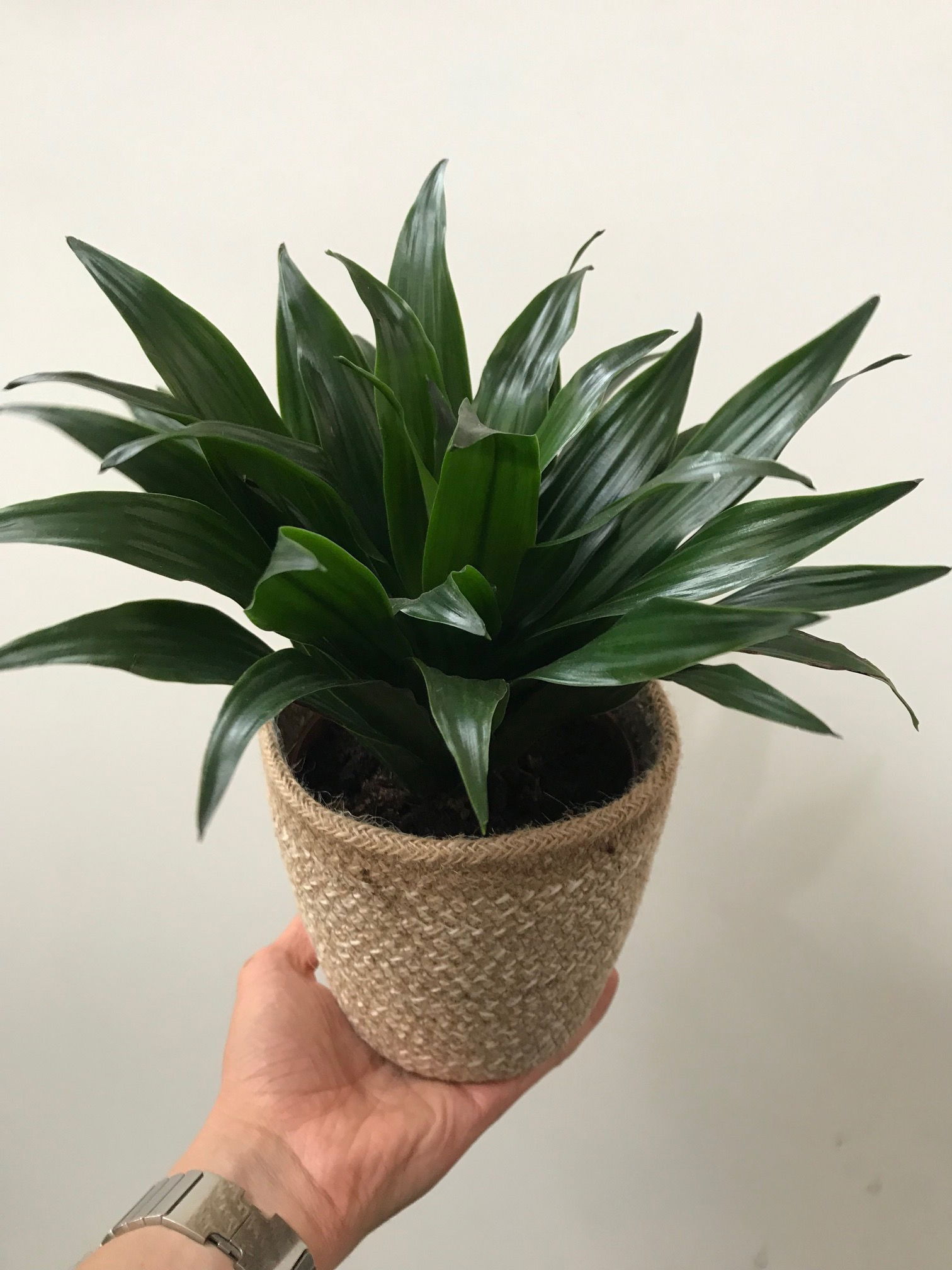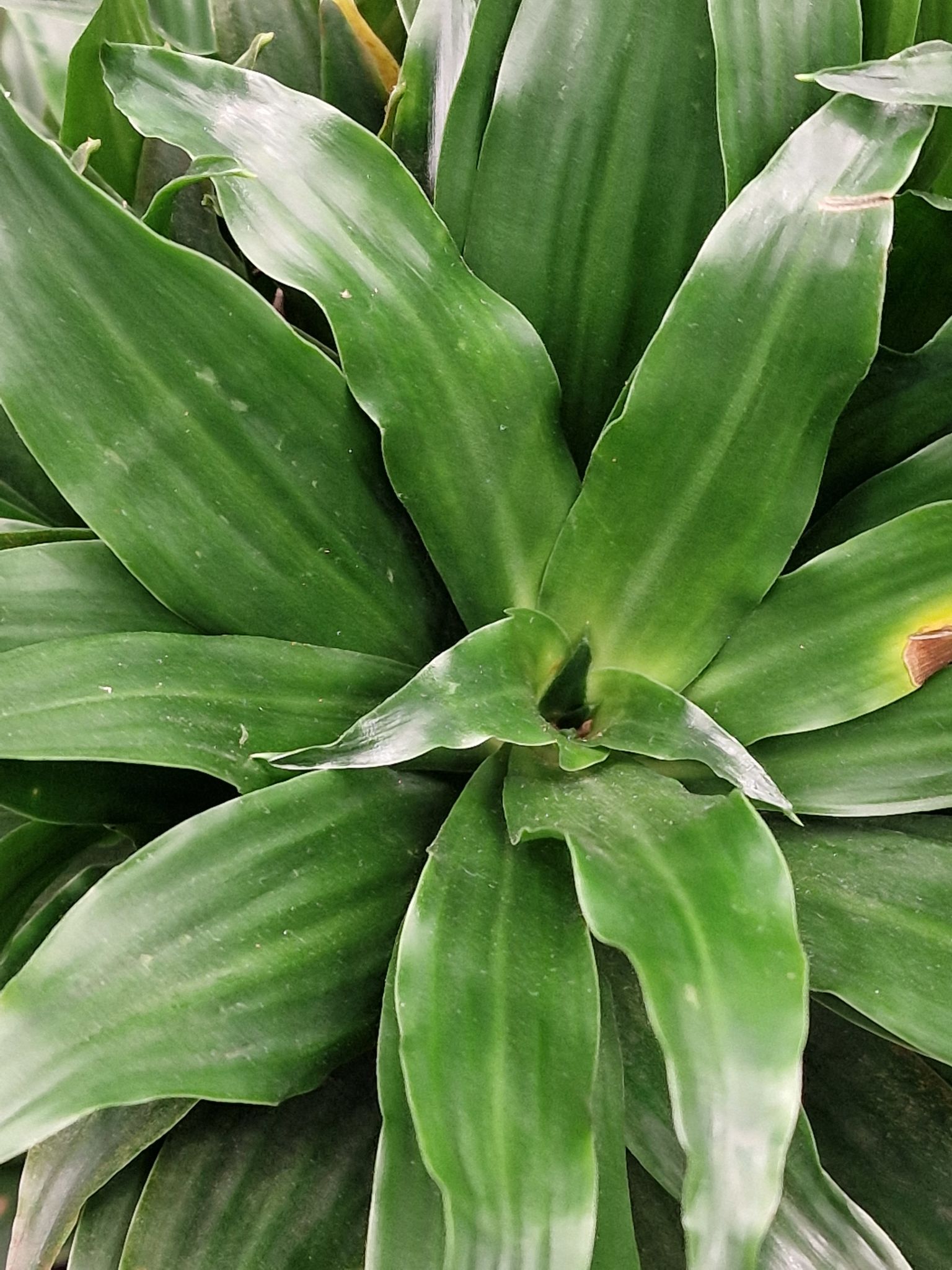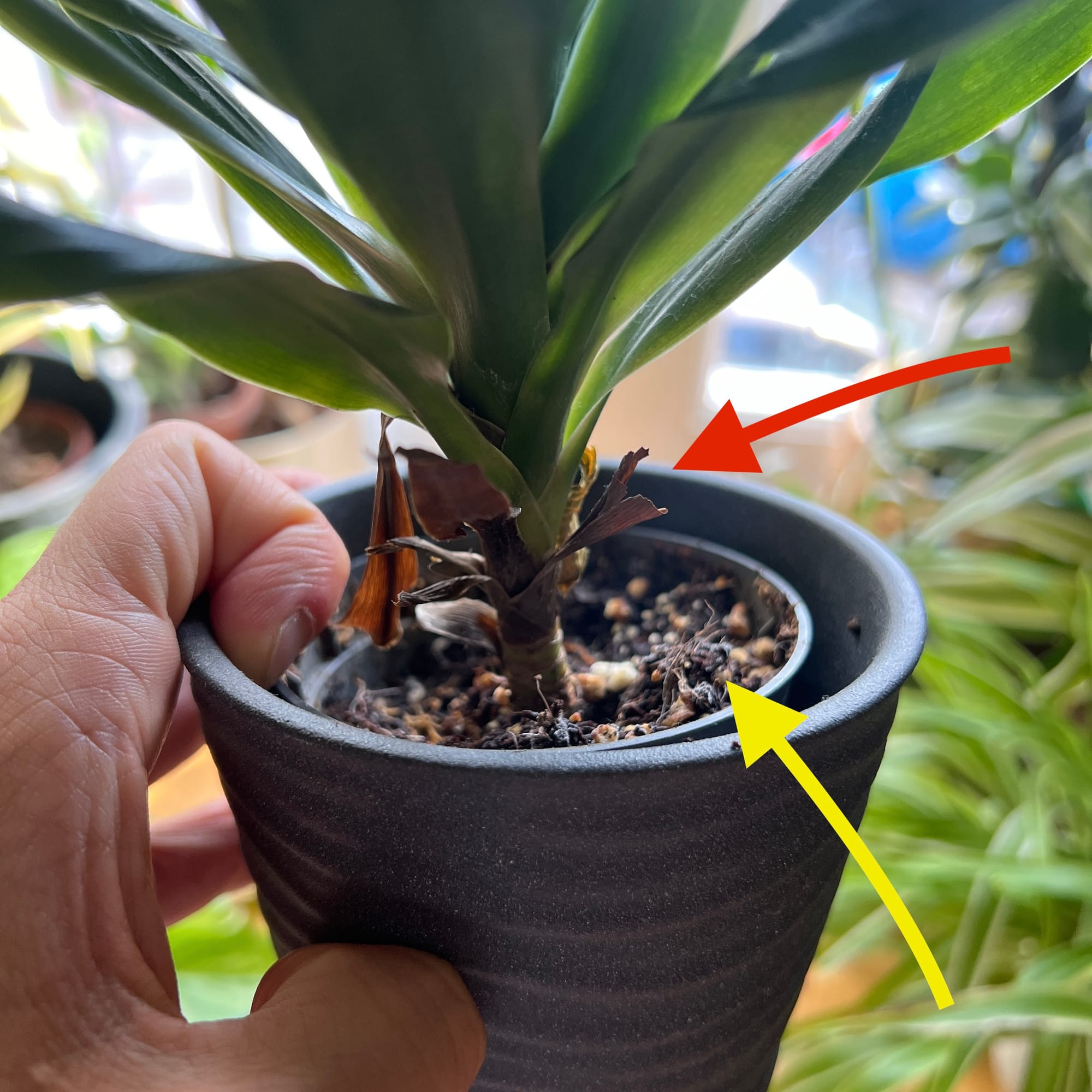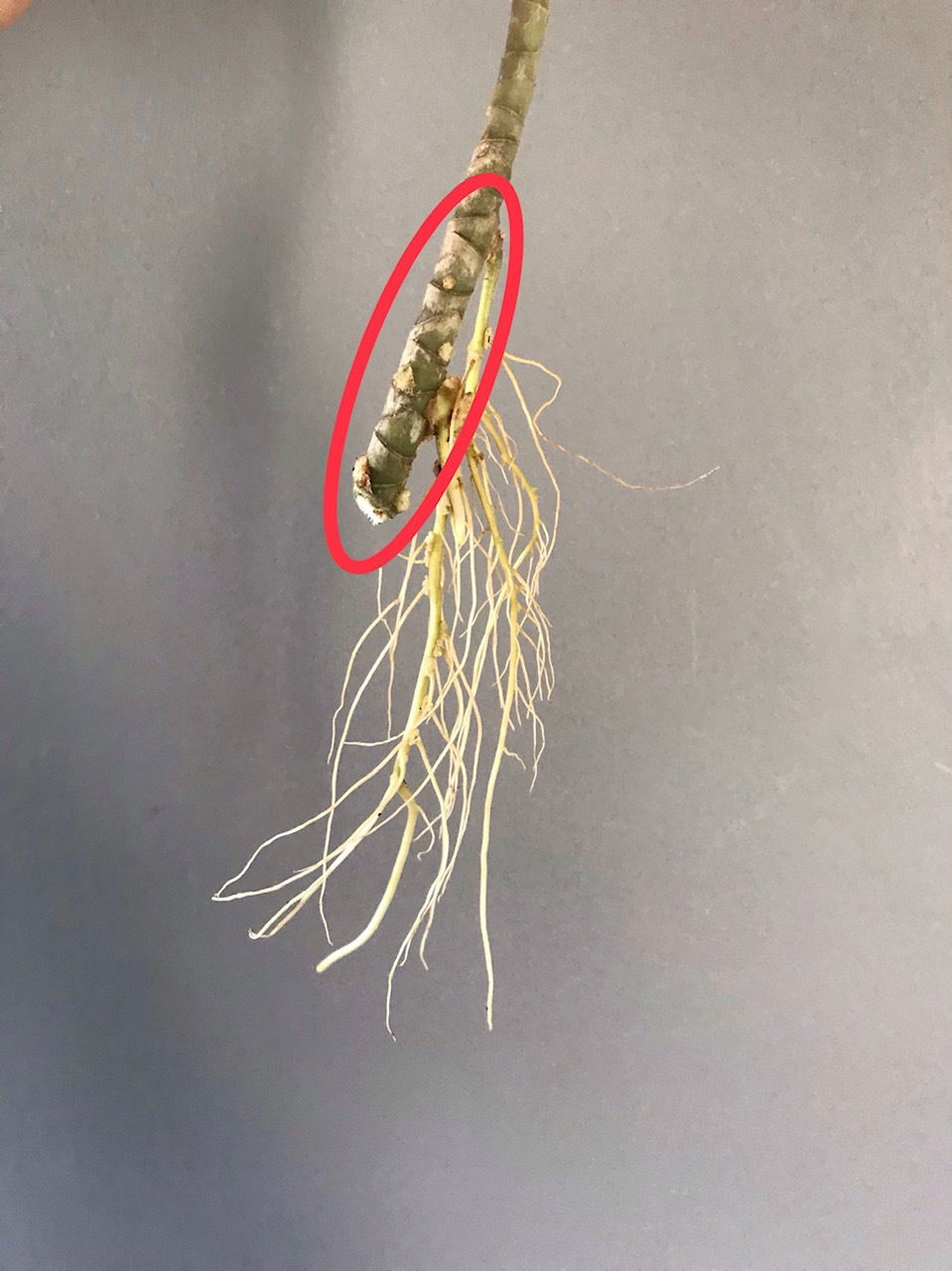
Dracaena fragrans 'Compacta'
Contents
- Top Tips
- Location, Water, Humidity & Fertilisation
- Common Issues
- Origins, Temperature, Propagation, Repotting & Toxicity.
Need the answer to a specific plant query? Book a 1-to-1 video call with THE HOUSEPLANT DOCTOR™, the website's friendly author, to overcome and address your niggling problem! Available on iMessage, WhatsApp, Facebook Messenger & more.
Top Tips & Info
- Care Difficulty - Easy to Moderate
- This species of Dracaena like to be sat in bright, indirect light without the risk of excessive exposure to the sun. Although a darker location is accepted, be sure to keep the specimen on the drier side to avoid over-watering.
- Allow half of the soil to dry out in between irrigations, reducing this slightly further in the autumn and winter.
- Fertilise using a 'Houseplant' labelled feed every four waters in the spring and summer, reducing this to every six in the colder months.
- Repot every three years with a 'Houseplant' labelled compost & the next sized pot. Introduce some grit or broken terracotta at the base to promote better drainage & texture for the roots.
- Mealybugs & Spider Mites are common pests will all types of Dracaena; check in the cubbyholes of the stems & beneath the leaves for possible outbreaks.
- This species of Dracaena is one of NASA's recommended air-purifying houseplants, with research from their 1989 'Clean Air Study'. They can absorb the five most common airborne toxins in a domestic household, including Benzene, Formaldehyde & Ammonia.
Location & Light - 🔸🔸
Dracaena are brilliant for all ranges of indirect light. Not only can they deal with prolonged neglect in the form of dehydration, but their ability to withstand dark locations are second to none. Although Dracaena can be kept in dark settings, we'd recommend placing yours in a bright, indirect location within minimal sunlight. Excessive periods in the direct light will significantly increase the risk of sun-scorch and permanently damaged leaves.
If yours is kept in a shaded area, keep the specimen on the drier side and dust the leaves each month. This will alleviate the chance of root rot which is commonly associated with dark sites, by increasing photosynthetic rates and oxygen penetration in the soil. If you're worried about its location being too dark, if a newspaper can be read while having your back towards the window, you're good to go.
Water - 🔸
Dracaena originates on the continent of Africa, meaning that they can be prone to over-watering and root rot. Allow half of the soil to dry out in between waters, reducing this further in the autumn and winter. Dracaena situated in darker locations must be watered far less than with those grown in brighter areas to counteract the high risk of soil mould. Their root systems are highly sensitive to temperature change, so applying cold water will weaken the plant's lower portion over time. If you decide to use tap water (instead of rainwater collected from outside or fresh bottled water), allow it to stand for at least 24hrs to eliminate the ironised chemicals and icy temperature. Under-watering symptoms include dry leaf-edges and slowed growth, which is usually the product of too much sunlight/heat or forgetfulness. Over-watering symptoms include root/stem rot and rapidly declining health. Remove the plant's pot and inspect the lower portion of root rot; if the disease is present, head over to this article to learn more.
Humidity - 🔸🔸
Average room humidity is enough to satisfy this plant, as long as you don't live in an overly-dry climate. Never situate it within a few metres of an operating radiator due to the enriched chance of browning leaf-tips. If you are indeed worried about dry air, create a humidity tray to provide a moist and stable environment for your plant, which will also have the added benefit of slowing the rates of drying soil!
Fertilisation - 🔸
Feed every four waters during the growing period and every six in the autumn and winter, using a 'Houseplant' labelled fertiliser. Never apply a 'Ready to Use’ product into the soil without a pre-water first, as it may burn the roots and lead to yellowed leaves.
 The foliage of Dracaena fragrans 'Janet Craig'.
The foliage of Dracaena fragrans 'Janet Craig'.
Common Issues with Dracaena
Yellowing lower leaves (closest to soil) could be a sign of over-watering, but equally is a byproduct of maturity. If the older leaves rapidly become yellow in quick succession, over-watering could be to blame. People don't realise that a plant's root system needs access to oxygen too; when soil is watered, the air will travel upwards and out of the potting mix. A lack of accessible oxygen for the roots will cause them to subsequently breakdown over the oncoming days. Click on this link to learn more about root rot and how to address it.
Spider Mites are small, near-transparent critters, that'll slowly extract the chlorophyll from of its leaves. Have a check under the leaves, most notably along the midrib, for small webs and gritty yellow bumps. Click here to read our article about the eradicating Spider Mites, along with some extra tips that you may not find elsewhere!
White dusty markings on your Dracaena compacta are just mineral deposits from hard water. If you live in an area with this, try using an aquatic water softener like 'Seachem Prime' that'll remove hard metals, minerals and chlorine. You can also use this to wipe the leaves to remove the dusty markings.
Yellow spots with brown margins could be one of two reasons - see image below for visual reference.
1. Root rot could be an issue when the plant is kept moist all of the time and watered too often. Take the plant out of the pot and check for brown, softened roots that can be pulled off from the soil easily. Healthy roots will be plump, red-coloured and difficult to pull off from the soil.
2. Nutrient deficiencies could be to blame where the plant isn't being fertilised enough. Use a 'houseplant' labelled fertiliser once every third water to promote healthier new growth that'll eventually reduce the view of the affected leaves. Any leaves that are brown or yellow will always remain that colour; it's the new growth that you should focus on.
 Try not to worry if your Dracaena compacta only has one brown spotty leaf like this. Although it could be a sign of root rot or nutrient deficiency, it's completely normal for this plant to have up to three damaged leaves. If, however, there are more than four brown spots appearing on your plant, THE HOUSEPLANT DOCTOR™ would recommend to check the roots for root rot. If the plant has no healthy roots, you can still take a stem cutting to keep the plant's 'legacy' alive.
Try not to worry if your Dracaena compacta only has one brown spotty leaf like this. Although it could be a sign of root rot or nutrient deficiency, it's completely normal for this plant to have up to three damaged leaves. If, however, there are more than four brown spots appearing on your plant, THE HOUSEPLANT DOCTOR™ would recommend to check the roots for root rot. If the plant has no healthy roots, you can still take a stem cutting to keep the plant's 'legacy' alive.
Yellowing leaf-tips are the product of cold water or too much fluoride in the soil. This issue is caused by using tap water which hasn't sat for 24hrs to alleviate the chemicals via evaporation. We'd recommend switching it for collected rainwater or fresh bottled water to improve its health, along with the reduction of its fluoride-count. The older leaves will always bear the scars of the past, but the new foliage should be as good as new within the next month.
 Red Arrow: It's completely normal for your Dracaena compacta to have brown crispy leaves at the stem's base. These are just the older leaves that are ready to be pruned off.
Red Arrow: It's completely normal for your Dracaena compacta to have brown crispy leaves at the stem's base. These are just the older leaves that are ready to be pruned off.
Yellow Arrow: If you look closely, the soil has mould developing across its top layer. Further, the perlite has turned brown which is a sign that the soil is being watered too often. For now, you don't have to repot it as the plant isn't displaying signs of root rot.
A loss of variegations is caused by too little light. Although Dracaena is an excellent choice for shady locations, it'll come at the cost of its variegations. Move the plant into a brighter area with bright, indirect light to allow the variegations to appear on the new growth. If you aren't entirely displeased about the loss, simply skip this step. Alternatively, extreme variegations that hinder the plant from developing chlorophyll (green pigmentation) is typically caused by too much sunlight.
Origins
The genus, Dracaena, belongs to the Asparagaceae family that holds plants such as Hyacinths, Asparagus Ferns, Spider Plants, Sansevieria & Yuccas. The name derives from the Greek for a female dragon 'Drakaina', referring to the red sap and green foliage. The species' epithet, 'fragrans', refers to the fragrant blooms that were first coined by John Bellenden Ker Gawler.
 The Distribution of Dracaena fragrans.
The Distribution of Dracaena fragrans.
Temperature
12° - 32°C (54° - 90°F)
H1b (Hardiness Zone 12) - Can be grown outdoors during the summer in a sheltered location with temperatures above 12℃ (54℉), but is fine to remain indoors, too. If you decide to bring this plant outdoors, don't allow it to endure any direct sunlight as it may result in sun-scorch and dehydration. Regularly keep an eye out for pests, especially when re-introducing it back indoors.
Spread
Over 2m in height and 0.7m in width once they reach maturity. The ultimate height will take between 8 - 10 years to achieve, with around 12cm of new growth per season.
Pruning & Maintenance
Remove yellow or dying leaves, and plant debris to encourage better-growing conditions. While pruning, always use clean scissors or shears to reduce the chance of bacterial and fungal diseases. Never cut through yellowed tissue as this may cause further damage in the likes of diseases or bacterial infections. Remember to make clean incisions as too-damaged wounds may shock the plant, causing weakened growth and a decline in health.
Propagation
Via Seed & Stem Cuttings.
Stem Cuttings (Easy)
- Hygiene is the most crucial element of successful propagation. The secateurs must be dirt-free with a fresh (or well stored) batch of compost. As you'll be cutting through vulnerable tissue, using uncleanly equipment will introduce harmful pathogens to the cutting and its mother plant.
- For stem cuttings, the best specimens are those located at the leading growths. You should aim for a semi-wooded base that's pencil-thick and still juvenile to slightly bend. Never use diseased or weakened growth, as this will likely fail to root. If, however, the cutting is littered in Pests - fear not. Remove all of the affected areas using your fingers, including the eggs, 'HQ' and any webs. Wholly submerge the cutting for at least two days to drown and kill the pests. Check the cubbyholes before placing it in compost; it's far easier to address a pest attack while the plant is mobile (i.e. without soil) than it would be in the soil. If the pests don't die after five days of full submersion, use an organic pesticide to help the eradication process, maintaining full water-submersion until the infestation is deemed destroyed. For more information about an outbreak and how it can be addressed, click here.
- Make the best incision possible to prevent the development of disease and remove the bottom half of the leaves.
- Decide on rooting the cutting via water or soil. The first option tends to have better success, especially if you're a new-time propagator. For the prior method, remove any rotten debris and replace the water every week with lukewarm tap water to prevent shocking the plant. Although collected rainwater is acceptable, the risk of harboured diseases is too high, especially with an open wound. Once the roots surpass 3cm, you can safely pot it up.
 After several weeks in water, areas will begin to callous (small white bumps), thus starting the rooting process.
After several weeks in water, areas will begin to callous (small white bumps), thus starting the rooting process. - For both options, (water & soil) use an aerated soil that has a fluffy texture with some perlite, too. Never use a poorly stored bag of compost as it'll promote larvae or perennial seeds to arise. We would recommend using 'Houseplant Compost' as it has a great balance between being water-retentive, but still 'airy' enough to promote root growth. Use a 7cm pot that has adequate drainage holes.
- Place a 2cm layer of soil at the bottom of the pot, and then rest the cutting vertically in the middle. You may have the cutting for support.
- Fill the soil around its base, making sure that its bottom half is submerged and NOT the leaves.
- Never press or compact the soil; condensing it to support the cutting will push the oxygen above the soil line, suffocating the roots until they rot. If it needs support, introduce a cane or something that won't condense the soil when inserted!
- Place the potted cutting in a transparent bag or box. Because of the lack of roots, it'll start to lose stored water very quickly. A confided environment will lock-in the humidity and reduce the rate of respiration and transpiration considerably.
- You'll rarely have to water the soil due to the high humidity. If the soil compacts itself after the first irrigation, level it out by adding more compost.
- Open the bag every few days for fresh air. Be sure to keep the soil evenly moist, but NOT soggy - if it looks saturated, leaves it. The surrounding humidity in the container will do its job by hydrating the leaves.
- Situate in a bright, indirect location away from any heat sources (i.e. radiators). Keep the temperature around 18℃ (64℉) as this is the optimum temperature for root development - you can even use a bottom-heat pad to speed-up the process. The roots will develop BEFORE the foliage, so bear that in mind if you're an impatient gardener. Safely remove the bag or box once new leaves emerge, as, at this point, there'll be a sufficient root system. Introduce a Pebble Tray to maintain a good level of atmospheric saturation and to reduce the severity of environmental shock
- Keep the soil moist and maintain a bright, indirect location away from direct sunlight and other heat sources. After around four months, transplant into a slightly bigger pot, keeping in mind transplant shock (where the root hairs are damaged or over-touched) and follow the care-tips provided above.
Flowers
Small, globular white or pink flowers are arranged along a thick flower shaft that'll appear horizontally towards the top half of the stem, lasting several weeks. It's highly unlikely that a domestically grown specimen will bloom indoors due to the unfavored growing conditions of too low humidity and consistent temperature levels throughout the year.
 The flowers of Dracaena have a sweet-fragrance, lasting several weeks. Credit: @its_lourds_castelo
The flowers of Dracaena have a sweet-fragrance, lasting several weeks. Credit: @its_lourds_castelo
Repotting
Repot every three years in the spring, using a 'Houseplant' labelled compost and the next sized pot with adequate drainage. If your specimen lives in a shady area of the home, you can use a 'Cactus & Succulent' labelled potting mix to increase drainage and reduce the risk of over-watering. Hydrate the plant 24hrs before tinkering with the roots to prevent the risk of transplant shock. Add a thin layer of small grit in the pot's base and the lower portion of the new compost to improve drainage & downplay over-watering. Click here for a detailed step-by-step guide on transplantation, or via this link to learn about repotting with root rot.
Book a 1-to-1 video call with THE HOUSEPLANT DOCTOR™ if you'd like a personal guide to repotting your houseplant. This will include recommending the right branded-compost and pot size, followed by a live video call whilst you transplant the specimen for step-by-step guidance and answer any further questions!
Pests & Diseases
Keep an eye out for mealybugs, spider mites, scale, thrips & whitefly that'll locate themselves in the cubbyholes and undersides of the leaves. Common diseases are root rot, leaf-spot disease, botrytis, powdery mildew & southern blight - click here to learn more about these issues.
Toxicity
This plant is classified as poisonous. If parts of the plants are eaten, vomiting, nausea and a loss of appetite could occur. Consumption of large quantities must be dealt with quickly - acquire medical assistance for further information.
Retail Locations
British Garden Centres, B&Q, Dobbies, Homebase, Tesco, IKEA, Online Stores.
Book a 1-to-1 Call with THE HOUSEPLANT DOCTOR™
If you need further advice with your houseplants, book an advice call with ukhouseplants' friendly and expert writer today! This can be done via a video or audio call on most apps, including Facebook, FaceTime & Skype. A ten-minute call costs £5.99 (US$7), or £15.99 for thirty minutes. You can ask multiple questions, including queries on plants, pests, terrariums, repotting advice and anything in between. Please consider supporting this service to keep ukhouseplants thriving!